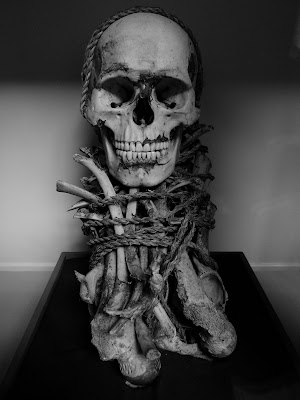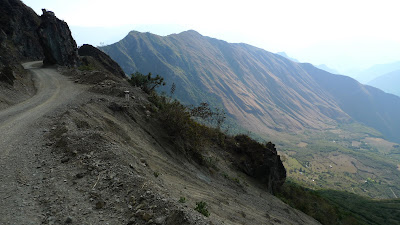
Tingo – Leimebamba – Abra Barros Negros – Balsas –We rode from Tingo up the river valley to Leimebamba where we finally leave the Utucamba River valley after 200+km. Road is still quiet and the towns are quieter - with not much bar action but the pigs are friendly.


Leimebamba is small and we see the same folks from Tingo and Chachapoyas. But it was a charming place to eat, get a hot shower, and spend the night. I pick up a bag of coca leaves to

chew and a gourd for "cal," or quicklime, in anticipation of the big climbs ahead. Coca is traditional to chew in the highlands, helps with altitude, nice energy, and good to share. Coca leaves are legal in Peru and readily available but people never sell the cal with the leaves . . . why, I do not know? But you always have to go to a hardware store to get the cal (used for masonry). The cal, or quicklime, is mixed in small amounts with the coca leaves in your mouth to release the alkaloids from the coca leaves. I went to a corner hardware store to buy some cal and the owner then led me back to the hostal I was staying at, then into a back storage/living area where we sampled some cal out of 50kilo bags to get some that was "hot." The hard part was getting the powder into a hole the size of a pen top at the top of the gourd, but it was free, and we chatted after wards. Peruvians are always a little surprised when a gringo chews coca leaves . . . I just like the gourds.
We start out a little late in the morning because we want to see if the day will clear or if it will rain and neither of us want to climb a big pass on a dirt road in a cold rain. Also, I wanted to see the museum on the outskirts of town that did not open until 10am where Dylan continued on. The museum is small but obviously well funded, probably due to a unique collection

of over 200 mummies all from Laguna de los Condores. A large collection of well preserved dead bodies from the same place over a given time available to study is an evolutionary biologists wet dream. Overall, the museum, while nice, is sparse on information about the actual Chachapoyan culture because not much is known. They called “warriors of the clouds,” but eventually subjugated by the Inka Empire, then allied themselves to the Spaniards, the enemy of my enemy . . . Take your pick of imperialists. However, I did learn some things about contemporary Andean cultures and architecture.

Curious Head Wear


Then the climbing began on a beautiful narrow dirt road with little traffic. Passing through small farming communities for the 30 kilometer climb up to 3620 meters over the Barros Negros (black mud) pass – thankfully, it was dry.

I stopped for lunch after climbing for a couple hours while finishing up lunch a young man stepped off a bus and walked over to talk - curious about a gringo in full bike regalia with a touring bike. I was just opening my bag of coca leaves for the climb and offered. He gratefully accepted and we chatted while sharing coca leaves. He was going to hike up to a small farm (potatoes and corn) about two hours into the mountains. The sharing of coca is a traditional social practice in the high Andes, that I have used often in the past, and was glad to have some to share because it is a real ice breaker. The views were expansive as the landscape of the high sierra opened .




I topped out at 3pm and prepared for a long descent of over 2800mts to Chacanto. I would need maybe 10 pedal strokes for the rest of the afternoon. I had to tell myself to get riding and stop taking photos if I wanted to complete the 60km descent before dark. Even if I was standing on the local dump it was still breathtaking. I had clear views of long

stretches of the descent, which was important because the road was narrow, single lane, bailing to the left was impossible because it was usually a wall and to the right was the drop for life. I figure the best you could hope for was to die quick otherwise you were going to land in a crumpled broken heap a thousand feet down to die slowly with no one knowing you were even there. Reminded me of the Buddhist phrase “abandon hope” - best to leave nothing to hope and pay attention to your task at hand.

Sections of the road were literally carved into cliff face with room for only one vehicle.

Signs warned about excessively narrow sections and told drivers to honk their horns before rounding single lane hairpin turns.

Eventually I arrived in the Maranon river valley towards dusk and met Dylan sitting on a bench in the plaza where we had a well earned ice cold beer. The town turned out to be very small with half the residents playing volleyball by the plaza

in front of the police station and a single house renting rooms, well a room, with the bathroom “down by the river.” We ate, had a couple beers then passed a hot stuffy night with the black flies before rising for the next big climb.

 Does this look anywhere near the ocean?
Does this look anywhere near the ocean? Peruvians love their seafood and ceviche is ubiquitous. No matter where you are there is ceviche, which used to make me leery, after all how far from the ocean am I? But now I eat with abandon! "Flipper" is a family owned "chain" of three "Flippers." Enjoy Susan!
Peruvians love their seafood and ceviche is ubiquitous. No matter where you are there is ceviche, which used to make me leery, after all how far from the ocean am I? But now I eat with abandon! "Flipper" is a family owned "chain" of three "Flippers." Enjoy Susan!
 The coca plant was first domesticated in the Andes 2-3000 years ago. Coca is a bush that grows wild and cultivated up to ten feet high on the lower eastern slopes of the Andes. Coca plays a significant role in traditional and contemporary Andean culture medicinally, commercially, and religiously. Coca is a mild stimulant that suppresses hunger, pain, thirst and fatigue, plus quells upset stomach and headaches associated with altitude - making it great for all those 12000 - 16000 foot passes on a bike! Also, coca actually increases sexual stamina instead of just making you think you look sexy like cocaine. New leaves are harvested from the plants three times a year and sold legally in markets throughout the Andes. Traveling throughout the high sierra it is rare to not see someone chewing coca when they are working. The tell tale rim of green around the mouth, the bulging cheek, white teeth scoured from chewing the leaves, and the cal dipper moving from gourd to mouth as they stroll across a field. Often when I meet people in the high Andes one of the first social acts is to offer coca then conversation begins.
The coca plant was first domesticated in the Andes 2-3000 years ago. Coca is a bush that grows wild and cultivated up to ten feet high on the lower eastern slopes of the Andes. Coca plays a significant role in traditional and contemporary Andean culture medicinally, commercially, and religiously. Coca is a mild stimulant that suppresses hunger, pain, thirst and fatigue, plus quells upset stomach and headaches associated with altitude - making it great for all those 12000 - 16000 foot passes on a bike! Also, coca actually increases sexual stamina instead of just making you think you look sexy like cocaine. New leaves are harvested from the plants three times a year and sold legally in markets throughout the Andes. Traveling throughout the high sierra it is rare to not see someone chewing coca when they are working. The tell tale rim of green around the mouth, the bulging cheek, white teeth scoured from chewing the leaves, and the cal dipper moving from gourd to mouth as they stroll across a field. Often when I meet people in the high Andes one of the first social acts is to offer coca then conversation begins.
































































